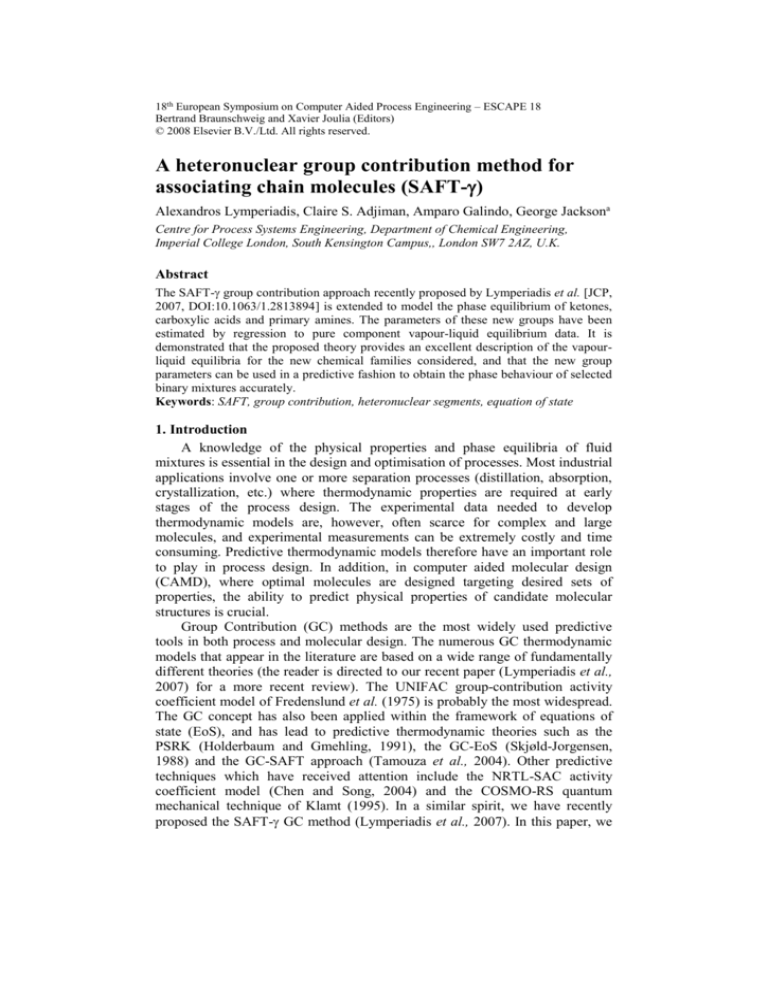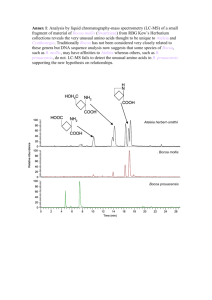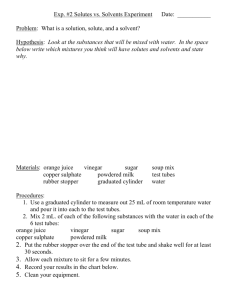
18th European Symposium on Computer Aided Process Engineering – ESCAPE 18
Bertrand Braunschweig and Xavier Joulia (Editors)
© 2008 Elsevier B.V./Ltd. All rights reserved.
A heteronuclear group contribution method for
associating chain molecules (SAFT-)
Alexandros Lymperiadis, Claire S. Adjiman, Amparo Galindo, George Jacksona
Centre for Process Systems Engineering, Department of Chemical Engineering,
Imperial College London, South Kensington Campus,, London SW7 2AZ, U.K.
Abstract
The SAFT- group contribution approach recently proposed by Lymperiadis et al. [JCP,
2007, DOI:10.1063/1.2813894] is extended to model the phase equilibrium of ketones,
carboxylic acids and primary amines. The parameters of these new groups have been
estimated by regression to pure component vapour-liquid equilibrium data. It is
demonstrated that the proposed theory provides an excellent description of the vapourliquid equilibria for the new chemical families considered, and that the new group
parameters can be used in a predictive fashion to obtain the phase behaviour of selected
binary mixtures accurately.
Keywords: SAFT, group contribution, heteronuclear segments, equation of state
1. Introduction
A knowledge of the physical properties and phase equilibria of fluid
mixtures is essential in the design and optimisation of processes. Most industrial
applications involve one or more separation processes (distillation, absorption,
crystallization, etc.) where thermodynamic properties are required at early
stages of the process design. The experimental data needed to develop
thermodynamic models are, however, often scarce for complex and large
molecules, and experimental measurements can be extremely costly and time
consuming. Predictive thermodynamic models therefore have an important role
to play in process design. In addition, in computer aided molecular design
(CAMD), where optimal molecules are designed targeting desired sets of
properties, the ability to predict physical properties of candidate molecular
structures is crucial.
Group Contribution (GC) methods are the most widely used predictive
tools in both process and molecular design. The numerous GC thermodynamic
models that appear in the literature are based on a wide range of fundamentally
different theories (the reader is directed to our recent paper (Lymperiadis et al.,
2007) for a more recent review). The UNIFAC group-contribution activity
coefficient model of Fredenslund et al. (1975) is probably the most widespread.
The GC concept has also been applied within the framework of equations of
state (EoS), and has lead to predictive thermodynamic theories such as the
PSRK (Holderbaum and Gmehling, 1991), the GC-EoS (Skjøld-Jorgensen,
1988) and the GC-SAFT approach (Tamouza et al., 2004). Other predictive
techniques which have received attention include the NRTL-SAC activity
coefficient model (Chen and Song, 2004) and the COSMO-RS quantum
mechanical technique of Klamt (1995). In a similar spirit, we have recently
proposed the SAFT- GC method (Lymperiadis et al., 2007). In this paper, we
2
A. Lymperiadis et. al.
extend its applicability by adding several new groups to the existing parameter
table, and demonstrate its predictive capability for highly non-ideal mixtures.
2. Theoretical background
The SAFT- GC approch is based on the popular SAFT-VR equation of
state (Gil-Villegas et al., 1997). The SAFT-VR EoS is seen to describe
accurately the fluid phase behaviour of a wide range of systems, from small
strongly-associating molecules, to long-chain molecules and charged systems.
Within the SAFT- modelling framework molecules are represented as
collections of fused heteronuclear square-well groups (e.g., see the models of
propane and 1-propanol depicted in Figure 1). A fused group k is characterised
by a hard-core diameter kk, a square-well depth kk and range kk, a key new
shape factor parameter Sk (which denotes the extent to which each group
contributes to the overall molecular properties) and, if appropriate, one or more
site types, the number of sites of each type, and the relevant well depth (HBab)
and range (rcab) of the associating site-site interaction. The cross parameters
(kl, kl, kl, HBlab and rclab) for the interactions with other groups l also need to
be defined. The cross hard-core diameter kl and square-well range kl are
obtained by simple arithmetic relations while the cross dispersive energy
parameter kl is fitted to experimental data.
Figure 1: Schematic of the SAFT- molecular model for (a) propane and (b) 1-propanol.
As with other SAFT descriptions of the thermodynamic properties, in the
SAFT- approach the Helmholtz free energy of a mixture of fused heteronuclear
model molecules is written as the sum of ideal, monomer, chain and associative
contributions, so that
A
A IDEAL A MONO ACHAIN A ASSOC
Nk BT
Nk B T
Nk B T
Nk BT
Nk B T
,
(1)
where AIDEAL is the ideal free energy, AMONO corresponds to the residual free
energy due segment-segment interactions (note that a group may have more
than one segment), ACHAIN takes into account the formation of chains of
heteronuclear groups, and AASSOC corresponds to the residual free energy due to
site-site interactions on associating groups. N is the total number of molecules,
kB Boltzmann’s constant, and T the absolute temperature. For a detailed
description of each of the contributions the reader is directed to the work by
Lymperiadis et al. (2007).
SAFT-: A heteronuclear group contribution method for associating chain molecules 3
3. Estimation of group parameters
The group parameters are estimated from pure component vapour pressure
Ps and saturated liquid density l experimental data making use of a leastsquares objective function. In the parameter estimation procedure, the CH3 and
CH2 parameters are initially regressed to optimise the description of the nalkane phase behaviour. These optimal values of the n-alkane group parameters
are then transferred to another chemical family so that the parameters of each
new group are estimated in a sequential manner. Following this methodology
we have obtained (Lymperiadis et al., 2007) the parameters of the CH3CH
group from data for branched alkanes, those for the ACH and ACCH2 groups
from data for n-alkylbenzenes, those for the CH2= and CH= groups from data
for mono- and di-unsaturated hydrocarbons, and those for the OH group from nalkan-1-ol data. In this work we present the parameters of three additional
groups: the parameters for the C=O group, obtained from data for 2-ketones,
those for the COOH group, from data for carboxylic acids, and those for the
NH2 group from data for primary amines. The parameters for the new groups
investigated are shown in tables 1 and 2.
Table 1. Individual group parameters for the SAFT- equation of state. The groups denoted with
an asterisk are modelled by more than one identical segment; the C=O group is modelled as two
spherical segments, and the COOH group is modelled as three segments one of which has one site
of type a. The NH2 group has two two sites of type a and one of type b.
Group
/Å
(/kB)/K
S
(HBab/kB)/K
rcab/ Å
CH3
CH2
C=O*
COOH*
NH2
3.810
4.027
2.787
2.806
3.908
1.413
1.661
1.782
1.538
1.527
252.601
240.482
386.833
269.285
398.872
0.667
0.333
0.482
0.644
0.472
-
-
3594.295
953.630
2.244
2.637
Table 2. Cross group energy parameters (l/kB)/K for the SAFT- equation of state.
Groups
C=O*
COOH*
NH2
CH3
CH2
C=O*
COOH*
NH2
294.070
207.512
386.833
-
257.515
283.497
269.285
-
283.840
308.722
398.872
The overall %AADs1 for all the classes of compounds examined in this and
previous (Lymperiadis et al., 2007) are summarised in table 3. The SAFT-
approach provides an accurate description of the experimental data for the
various chemical families over wide ranges of temperatures: the overall %AAD
for all compounds is 3.34% for the vapour pressure and 0.92% for the saturated
liquid density. The representation of the saturated liquid density is particularly
good. The best description of the experimental data is obtained for two of the
1
%AAD is the average percentage error (absolute value) over all data points.
4
A. Lymperiadis et. al.
associating classes of compounds studied: the primary amines, and the 1alkanols. This is probably due to the dominant effect of hydrogen bonding on
the phase equilibria of these substances. The excellent description of the
vapour-pressure and coexistence densities for the 2-ketones, carboxylic acids
and primary amines is evident from figures 2 and 3.
Table 3. Overall average absolute deviations (%AAD) of vapour pressures Ps and saturated liquid
densities l within the SAFT- framework compared to experiment for all the chemical families
included in the database.
Chemical family
No Fitted Compounds
% AAD Ps
% AAD l
n-alkanes
branched alkanes
n-alkylbenzenes
alkenes
2-ketones
carboxylic acids
primary amines
1-alkanols
Average % AAD
9
10
9
19
8
8
9
9
-
3.98
2.92
4.12
4.78
3.47
3.60
1.64
2.19
3.34
0.57
0.39
1.49
0.74
1.14
1.42
0.53
1.09
0.92
Figure 2: Vapour pressures curves for: a) 2-ketones (propan-2-one to undecan-2-one except decan2-one), b) carboxylic acids (propanoic acid to decanoic acid), c) primary amines (ethylamine to
decan-1-amine). The circles represent the experimental data, and the continous curves the SAFT-
description.
SAFT-: A heteronuclear group contribution method for associating chain molecules 5
Figure 3: Saturated liquid densities for: a) 2-ketones (propan-2-one to nonan-2-one), b)
carboxylic acids (propanoic acid to decanoic acid), c) primary amines (ethylamine to decan-1amine). The symbols represent experimental data, and the continous curves the SAFT-
description.
4. Prediction of mixture properties
We examine the predictive capability of the method in describing mixtures
of compounds formed from some of the new groups presented by considering
the four binary mixtures shown in Figure 4. The advantage of our approach is
that the unlike energy parameters between different group types can be
estimated from pure component vapour-liquid equilibrium data, without the
need for mixture data. Thus, the prediction of the phase equilibria of binary
mixtures is a straightforward procedure based on the tabulated parameters. As
can be seen in the figure, the SAFT- EoS provides an excellent description of
the fluid phase behaviour of the mixtures studied.
5. Conclusions
The parameter matrix of the SAFT- group contribution EoS is enriched
with three new groups: the carbonyl C=O, carboxyl COOH and amino NH2
groups. It is shown that the approach provides an excellent description of the
phase behaviour of the chemical families used to estimate the parameters, and
furthermore, that it is capable of predicting accurately the phase behaviour of
various classes of binary mixtures comprising the new groups. In future we will
be enhancing the applicability range of this promising approach by treating
6
A. Lymperiadis et. al.
other important groups and we will also investigate the application of the
technique for liquid-liquid equilibria (LLE), solid-liquid equilibria (SLE), and
solvent design through computer-aided methods.
Figure 4: Predicted vapour-liquid equilibria diagrams for selected binary mixtures with SAFT-.
The symbols represent the experimental data and the continuous curves correspond to the SAFT-
predictions. The binary mixtures shown are: a) 1-butene + propene where x1 is the mole fraction
of 1-butene, b) n-hexane + propanone where x1 is the mole fraction of n-hexane, c) n-heptane +
pentanoic acid where x1 is the mole fraction of n-heptane, and d) n-heptane + butan-1-amine
where x1 is the mole fraction of n-heptane.
Acknowledgements
A.L. gratefully thanks Britest and the Engineering and Physical Sciences Research
Council (EPSRC) of the UK for the award of a PhD studentship. Additional funding
from the EPSRC (GR/N20317, GR/N03358, GR/N35991, GR/R09497, and
EP/E016340) is also acknowledged. We would also like to thank P. Crafts from
AstraZeneca for useful discussions.
References
A. Lymperiadis, C.S. Adjiman, A. Galindo and G. Jackson, 2007, Journal of Chemical Physics,
127, 234903.
A. Fredenslund, R.L. Jones and J.M. Prausnitz, 1975, AIChE Journal, 21, 1086.
T. Holderbaum and J. Gmehling, 1991, Fluid Phase Equilibria, 70, 251.
S. Skjøld-Jorgensen, 1988, Industrial & Engineering ChemistryResearch, 27, 110.
S. Tamouza, J.P. Passarello, P. Tobaly and J.C. de Hemptinne, 2004, Fluid Phase Equilibria, 222,
67.
C. Chen and Y. Song, 2004, Industrial & Engineering Chemistry Research, 43, 8354.
A. Klamt, 1995, Journal of Physical Chemistry, 99, 2224.
A. Gil-Villegas, A. Galindo, P.J. Whitehead, S.J. Mills, G. Jackson and A.N. Burgess, 1997,
Journal of Chemical Physics, 106, 4168.










